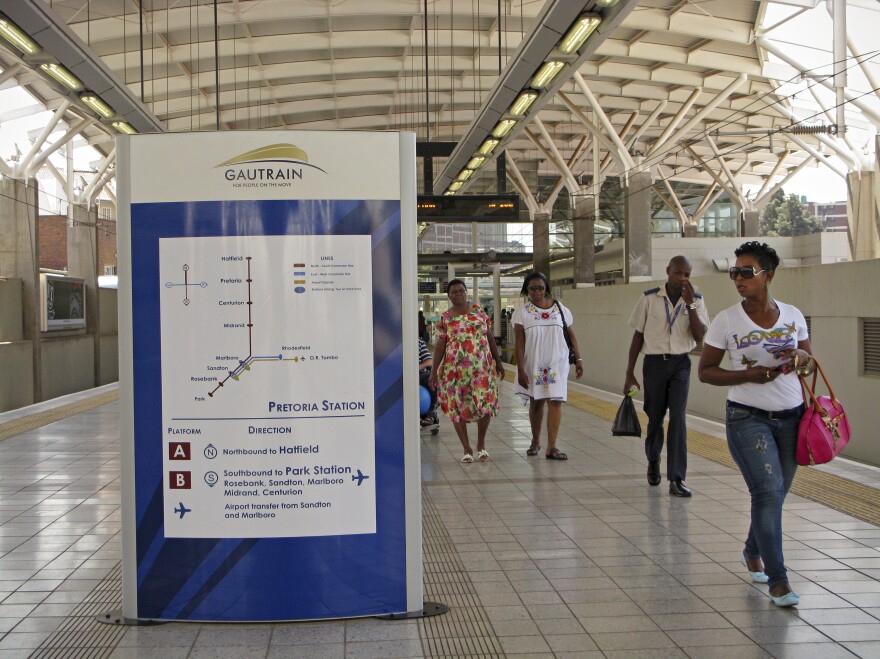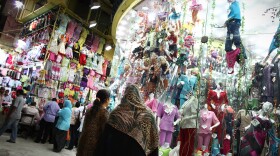Public transit in South Africa can be a bit of a nightmare. Many South Africans have had to depend on the ubiquitous taxivans, which are often overcrowded, dirty and driven recklessly.
But the continent's first rapid rail service, built to ease traffic congestion in South Africa's economic heart, is changing that.
The Gautrain links Johannesburg, the country's economic and business hub, and Pretoria, its political capital. With speeds of up to 100 mph, it is a smooth, swift, clean and chilly ride (complete with American-style air conditioning). And it's a safe ride, which is particularly important for a place like Johannesburg, known locally as Joburg, which has had a reputation for crime.
Meeting all of these challenges was no easy task for the operators of the $3 billion rail system. As one friend puts it, "If the Gautrain gets a name for grubbiness or crime, it's dead on the spot."
Clearing The Congestion
The idea behind the Gautrain was to get people using cars off the roads and onto public transportation in order to ease congestion.
For example, the drive between Joburg and Pretoria should take a little more than an hour. But it takes double that or much longer if you're stuck in traffic, which is often the case.

The Gautrain (pronounced HOW-TRAIN), which derives its name from Gauteng province, home to both Joburg and Pretoria, began service just before another first for Africa: the 2010 World Cup soccer championship hosted by South Africa.
The train network, with a stop at O.R. Tambo International Airport, has since expanded, and more stations are to come, says Kelebogile Machaba, a spokeswoman for Bombela Concession Co., which operates the Gautrain.
Early on in the project, there was considerable criticism about the planned network and fears that it would simply serve a rich elite, doing little for poor South Africans, because of the price of tickets.
And it's true that not everyone can afford the $18 one-way ride to the airport from downtown Joburg. But a taxi costs easily twice that amount.
Officials say the Gautrain is carrying up to 40,000 passengers daily on average, and in some ways, it's become something of a victim of its own success. It's mostly a commuter line, and hundreds, even thousands, of additional parking spots are needed at some stations.
The 2-year-old network has already reached nearly 100 percent capacity during peak hours. And the Gautrain's hours of operation are limited — from 5:30 a.m. until 8:30 p.m. Many complain that's too short, especially for those riding to and from the airport. But concerns about security late at night likely account for the early closing time.
Strict Rules
Despite the drawbacks, there are plenty of fans, including banker and regular Gautrain user Michelle Madden. On a recent day she was taking the 30-minute trip from Johannesburg for a meeting in Pretoria. She says she loves the train.
"It's convenient and it's very smooth, it's easy," she says.

She used to take taxis or buses, which she says were "terrible and dirty." She praises the cleanliness of the Gautrain, with its immaculate royal blue and gold livery.
"The buses are disgusting and have chewing gum all over the floor and the seats, and they have chicken bones under the chairs. It's disgusting," Madden says, laughing.
The Gautrain has strict rules: no chewing gum, no eating, no drinking.
Cheerful and polite, Chabalala Casper is one of about 400 security personnel patrolling Gautrains and stations.
"No one [is] allowed to eat or drink here. Even chewing is not allowed. Even water is not allowed to drink, ma'am," he says. Passengers say fair is fair because this keeps the trains clean.
I heard one tale of a woman who had to swallow everything — gum, drink and all — in a heartbeat when she realized that the guard moving with alacrity along the train's aisle was heading for her.
Another Satisfied Customer
First-time rider Refilwe Edith Seabi hops on the train in Pretoria. As someone accustomed to traffic jams, she has high hopes for her ride to Joburg, where she is taking her sister Girlie for shopping — and she's timing the scheduled half-hour ride.
"Because sometimes Johannesburg to Pretoria, it will take me two hours because of the traffic," Seabi says. "So, I want to see today what time I'm going to board it and what time I'm going to arrive."
Seabi is elated and a little bit on edge.
"I'm very much excited. ... But I'm anxious about its speed," she says with nervous laughter.
With a twinkle in her eye, as she leans back into a royal blue, upholstered Gautrain seat, Seabi says she has heard the train ride is comfortable.
She visibly relaxes as the train picks up speed, whizzing past cars on the roads.
As the Gautrain glides into Johannesburg's Sandton Station, Seabi smiles with satisfaction. It's bang on time.
"Yes," she tells me. "I'll certainly be taking the Gautrain again. Definitely."
Copyright 2024 NPR







